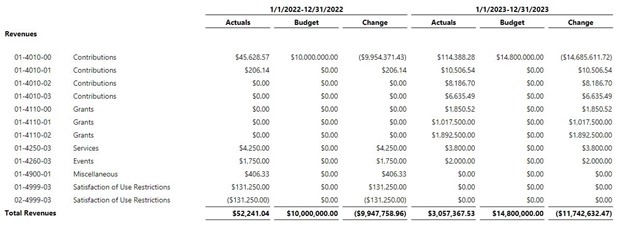Telling Your Nonprofit’s Financial Story: Key Elements for an Engaging Annual Report

It’s year-end wrap-up time. You’ve closed the books, successfully completed another audit season, and submitted all necessary filings. You are ready to put last fiscal year behind you.
Except for one last thing.
The annual report has an empty page with the heading “Full-Year Financials.” And you’re in charge of getting that information where it needs to go.
While there might be less regulatory or governance pressure hanging over this aspect of your yearly financial reporting, it’s important for your organization to have an annual report that attracts donors, inspires confidence in leadership, and demonstrates transparency. While perhaps not as demanding as your other reporting duties, the annual report can be a chance to focus on telling an engaging financial impact story. Let’s have a look at how we can use this opportunity to finish strong.
What’s an Annual Report even for?
Contrary to what the name may imply, an annual report is not just to report on the previous year’s activities and statistics. It’s an opportunity to celebrate milestones, thank your supporters, and get excited about what’s coming up in the next year. As a finance leader at your organization, you get to plug into all that goodness of the whole report—not just contribute to the previous year’s stats.
Know your audience
You’re probably used to supporting stakeholders who aren’t financial professionals reach an understanding of your organization’s financials. This could take the form of presenting financial statements at board meetings, planning a program budget with a department head, or advising the Executive Director on upcoming cash flow considerations.
Readers of the annual report will be similarly diverse in their familiarity with your organization’s financials and financial reporting in general. Somehow, you have to be there to support them and interpret the reports—with the added complication of not being in the room when they are going over the numbers. So, considering ways to build that translation into the report presentation itself is going to benefit everyone. Your fund accounting system will likely allow you to customize the headers and titles on the report, and when you save these parameter settings, you’re baking consistency and efficiency into the process so that next year’s reporting runs more smoothly as well.
Consider also the level of detail that will be helpful to your audience. You’ll probably find that the amount of detail necessary for managing your work on a day-to-day or governance basis is more than this audience cares to deal with—and may even overwhelm them. Take advantage of your fund accounting software’s ability to roll up totals and consolidate groups of similar accounts for simplification.
In Blackbaud Financial Edge NXT®, for example, you can set comparative columns to automatically print the date(s) in the headers. So rather than having your audience scratch their heads about what constitutes “This fiscal year” vs “Last fiscal year,” they’re seeing 7/1/2023-6/30/2024 in one column and 7/1/2022-6/30-2023 in the next. That Variance column? Rename that “Change.” For the body of the report, a chart organizer will help get to that sweet spot of just enough information without too much detail, rolling up multiple account codes or other groupings into a handful of broad, easily digestible categories.

Prepare for Questions
Get ahead of your audience’s potential questions by adding clear context in the notes. You might have boilerplate language locked and loaded for annual report financial statements but consider supplying—and keeping handy for the future—additional details about what makes this year unique. After several years of making and saving contextual supporting explanations, you’ll have more than just a single template to work from in the future. You’ll be able to mix and match to provide a truly unique accompanying set of notes, without having to rewrite them fresh each year.
Collaborate!
One objective of an annual report is to provide transparency, and that includes your colleagues in other departments as well. You’d hate, for instance, to receive the final proof before printing only to discover that the marketing team had to manually re-type your financial figures, and that due to an accidental transposition of numbers, nothing in the reports now makes any sense! Collaborating with key stakeholders during the creation process can help determine which format the intended audience requires. Would they rather receive a graphic as a .jpg or .png? Or do they want raw data for creating the pie chart themselves? In Financial Edge NXT web view reporting, Dashboards allow you to directly export the visuals that enhance your report results. And of course, it’s also possible to export the source data table to a .csv or .xlsx file.
At bare minimum, confirm which of the following elements will remain the same year over year, and what might change:
- Timeline: The more predictable your timeline, the easier it will be to prepare for contingencies, such as delegating tasks, requesting new deadlines, and deputizing colleagues as backups. Will there be a time crunch between Board approval of your final, audited financials and the deadline for delivering them? Be prepared!
- Format: Know the way the data should be presented, and how to break it out. Does your audience want each report to be a separate sheet in a single Excel document, or its own separate .csv file, or does it matter?
- Software: If the vendor or product being used has changed, be prepared for last-minute updates. Anticipate the need to adapt to or learn software when considering your process.
- Main Theme: What will be the focus or feature of this year’s report? Think about how you’ll tie your financial story to a broader theme. Maybe it’s calling out the resilience of a program in the notes, explaining how 50% of contributions came in response to an emergency call to action, or detailing a specific line item to emphasize the importance of individual contributions.
- Changes: Are there any other differences over last year going into the annual report, financials or otherwise? Take this time to consider how to prepare in advance as much as possible for this year’s needs, so the majority of the work during crunch time is spent on pulling and sharing reports. Utilize the Save As and Copy features on report parameters and chart organizers so you can invest that setup energy now and be more efficient later.
Looking Ahead
The annual report doesn’t have to be a chore. It’s a chance to celebrate the great work your organization does day after day, year after year—and you have unique insight into the financials that make it possible. The more prepared you are ahead of crunch time, the better—and maybe even calmer—the experience will be.
Check out the Blackbaud University Organizational Best Practices Finance: Year-End and Audit Plans to workshop this and more of your annual financial activities.
This piece was co-authored by Blackbaud University Instructors Maire Moriarty and Andrew Alter.


